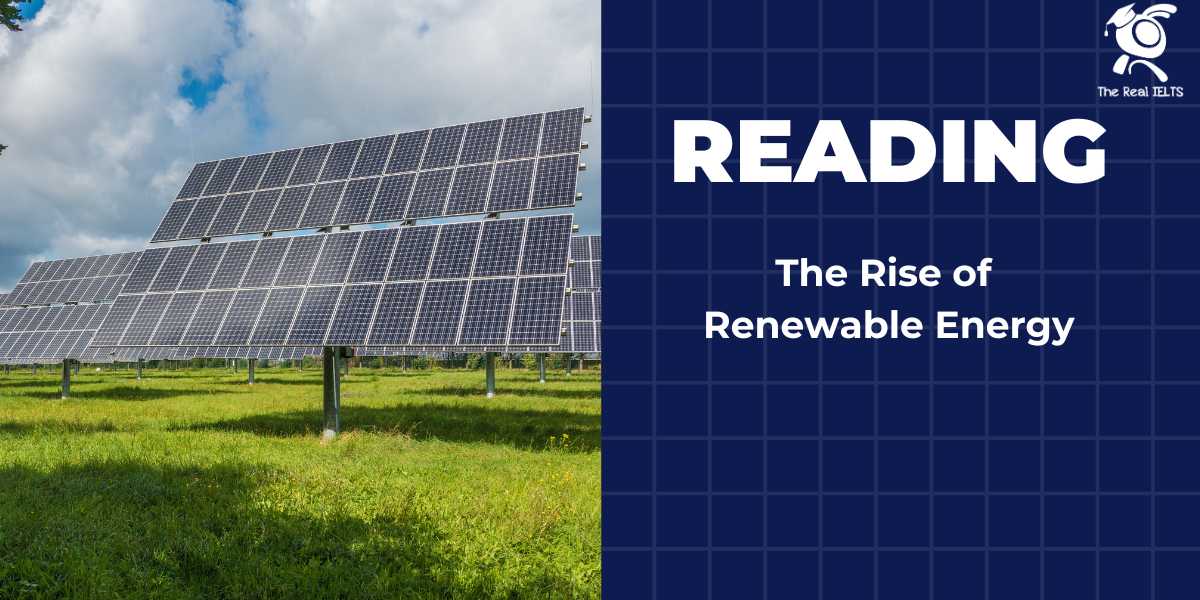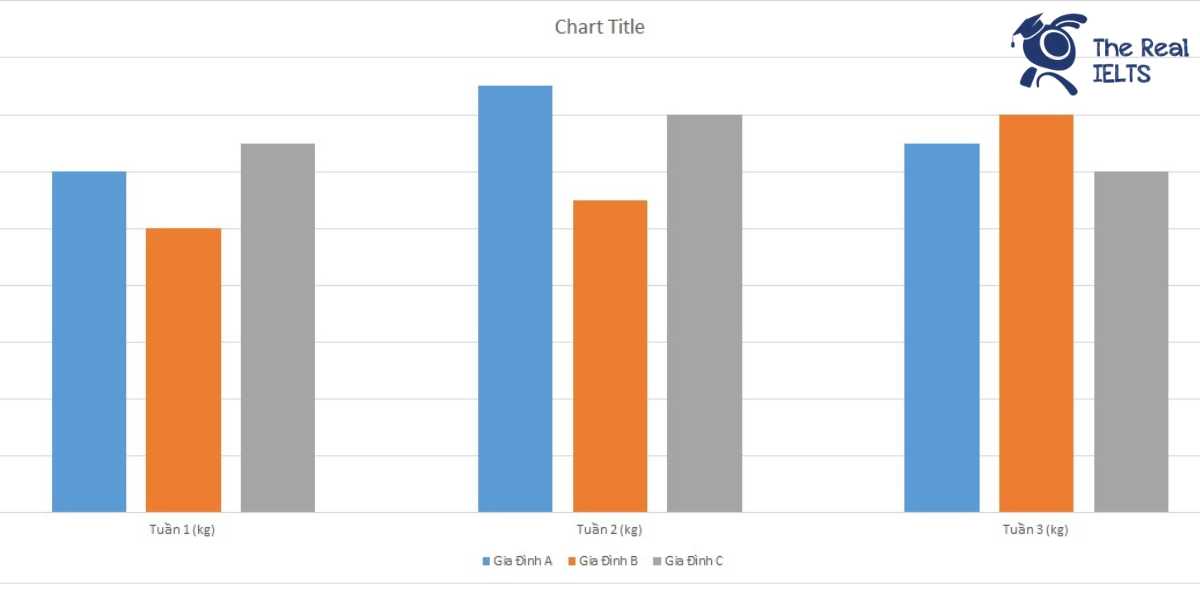Bài Reading này có chủ đề là The Rise of Renewable Energy. Chủ đề về năng lượng mới là chủ đề được nhiều kỳ thi sử dụng làm đề bài trong các mục thi Reading và Writing. Trong bài viết này chúng ta sẽ cùng nhau làm bài tập Reading về Renewable Energy.
Đọc thêm: Học IELTS từ 0 lên 6.5 mất bao nhiêu tiền?
The Rise of Renewable Energy
In recent years, the global energy landscape has been undergoing a profound transformation, marked by the rapid ascent of renewable energy sources. This shift is being driven by a combination of factors, including concerns over climate change, advances in technology, and evolving market dynamics.
One of the key drivers behind the rise of renewable energy is the growing recognition of the environmental and social costs associated with traditional fossil fuel-based energy sources. The burning of fossil fuels releases greenhouse gases such as carbon dioxide into the atmosphere, contributing to climate change and air pollution. In contrast, renewable energy sources such as solar, wind, and hydroelectric power generate electricity with minimal or no emissions, making them an attractive alternative for reducing carbon footprints.
Advances in technology have also played a crucial role in driving the adoption of renewable energy. Breakthroughs in solar panel efficiency, wind turbine design, and energy storage solutions have significantly lowered the cost of renewable energy generation, making it increasingly competitive with fossil fuels. Furthermore, innovations in grid management and smart energy systems have helped integrate renewable energy sources into existing infrastructure more effectively, enhancing their reliability and scalability.
Governments around the world have also been implementing policies and incentives to promote the growth of renewable energy. From feed-in tariffs to renewable energy targets, these measures are designed to encourage investment in clean energy projects and create a favorable regulatory environment for renewable energy development. Additionally, international agreements such as the Paris Agreement have set ambitious targets for reducing greenhouse gas emissions, driving further momentum towards renewable energy adoption on a global scale.
The rise of renewable energy is not only reshaping the energy sector but also creating new economic opportunities and job prospects. The renewable energy industry has become a significant source of employment, with jobs ranging from manufacturing and installation to research and development. Moreover, the decentralized nature of renewable energy production enables communities to become more self-sufficient and resilient in the face of disruptions to traditional energy supply chains.
Despite the remarkable progress made in the expansion of renewable energy, challenges remain. Issues such as intermittency, grid integration, and resource availability continue to pose obstacles to the widespread adoption of renewable energy. Addressing these challenges will require continued investment in research and development, as well as innovative solutions to optimize the performance and reliability of renewable energy systems.
In conclusion, the rise of renewable energy represents a paradigm shift in the global energy landscape, driven by environmental, technological, and economic factors. By harnessing the power of renewable energy, we can mitigate the impacts of climate change, reduce dependence on finite fossil fuel resources, and create a more sustainable and resilient energy future for generations to come.
Question
- What are some of the driving factors behind the increasing adoption of renewable energy sources?
- How do renewable energy sources compare to traditional fossil fuels in terms of environmental impact?
- What role have technological advancements played in the growth of renewable energy?
- How have government policies and international agreements contributed to the expansion of renewable energy?
- What are some of the economic benefits associated with the rise of renewable energy?
- What are some of the challenges that still need to be addressed in order to further advance renewable energy adoption?
- How does the decentralized nature of renewable energy production benefit communities?
- What are some examples of innovative solutions being developed to overcome challenges in renewable energy integration?
- How does the rise of renewable energy contribute to efforts to mitigate climate change?
- What are the long-term implications of the shift towards renewable energy for global energy security and sustainability?
Gợi ý trả lời
- The increasing adoption of renewable energy sources is driven by a combination of factors, including concerns over climate change, advances in technology, and evolving market dynamics.
- Renewable energy sources generate electricity with minimal or no emissions, making them more environmentally friendly compared to traditional fossil fuels, which release greenhouse gases and contribute to air pollution.
- Technological advancements have significantly lowered the cost of renewable energy generation, making it increasingly competitive with fossil fuels. Breakthroughs in solar panel efficiency, wind turbine design, and energy storage solutions have played a crucial role in this transformation.
- Government policies such as feed-in tariffs and renewable energy targets, along with international agreements like the Paris Agreement, have created a favorable regulatory environment for renewable energy development and set ambitious targets for reducing greenhouse gas emissions.
- The rise of renewable energy has created new economic opportunities and job prospects, with the renewable energy industry becoming a significant source of employment in sectors such as manufacturing, installation, and research and development.
- Despite progress, challenges such as intermittency, grid integration, and resource availability remain obstacles to widespread adoption. Addressing these challenges will require continued investment in research and development, as well as innovative solutions to optimize renewable energy systems.
- The decentralized nature of renewable energy production allows communities to become more self-sufficient and resilient in the face of disruptions to traditional energy supply chains.
- Innovative solutions being developed to overcome challenges in renewable energy integration include grid management technologies, energy storage solutions, and advancements in renewable energy forecasting.
- The rise of renewable energy contributes to efforts to mitigate climate change by reducing greenhouse gas emissions and decreasing dependence on finite fossil fuel resources.
- The shift towards renewable energy has long-term implications for global energy security and sustainability, helping to diversify energy sources and reduce reliance on geopolitically unstable regions for energy supply.
Phần song ngữ
The Rise of Renewable Energy
Sự Bùng Nổ của Năng Lượng Tái Tạo
In recent years, the global energy landscape has been undergoing a profound transformation, marked by the rapid ascent of renewable energy sources. This shift is being driven by a combination of factors, including concerns over climate change, advances in technology, and evolving market dynamics.
Trong những năm gần đây, cảnh quan năng lượng toàn cầu đã trải qua một sự biến đổi sâu sắc, được đánh dấu bởi sự bùng nổ nhanh chóng của các nguồn năng lượng tái tạo. Sự chuyển đổi này được thúc đẩy bởi sự kết hợp của nhiều yếu tố, bao gồm mối lo ngại về biến đổi khí hậu, sự tiến bộ trong công nghệ và sự phát triển của động lực thị trường.
One of the key drivers behind the rise of renewable energy is the growing recognition of the environmental and social costs associated with traditional fossil fuel-based energy sources. The burning of fossil fuels releases greenhouse gases such as carbon dioxide into the atmosphere, contributing to climate change and air pollution.
Một trong những yếu tố chính đằng sau sự bùng nổ của năng lượng tái tạo là sự nhận thức ngày càng tăng về các chi phí môi trường và xã hội liên quan đến các nguồn năng lượng truyền thống dựa vào nhiên liệu hóa thạch. Việc đốt cháy nhiên liệu hóa thạch tạo ra khí thải nhà kính như carbon dioxide vào không khí, góp phần vào biến đổi khí hậu và ô nhiễm không khí.
In contrast, renewable energy sources such as solar, wind, and hydroelectric power generate electricity with minimal or no emissions, making them an attractive alternative for reducing carbon footprints.
Trái lại, các nguồn năng lượng tái tạo như năng lượng mặt trời, năng lượng gió và năng lượng thủy điện tạo ra điện với lượng khí thải ít hoặc không có, khiến chúng trở thành một lựa chọn hấp dẫn để giảm lượng carbon footprint.
Advances in technology have also played a crucial role in driving the adoption of renewable energy. Breakthroughs in solar panel efficiency, wind turbine design, and energy storage solutions have significantly lowered the cost of renewable energy generation, making it increasingly competitive with fossil fuels.
Các tiến bộ trong công nghệ cũng đóng một vai trò quan trọng trong việc thúc đẩy việc sử dụng năng lượng tái tạo. Những bước tiến trong hiệu suất của tấm pin năng lượng mặt trời, thiết kế turbine gió và các giải pháp lưu trữ năng lượng đã giảm đáng kể chi phí sản xuất năng lượng tái tạo, khiến chúng trở nên cạnh tranh hơn so với nhiên liệu hóa thạch.
Furthermore, innovations in grid management and smart energy systems have helped integrate renewable energy sources into existing infrastructure more effectively, enhancing their reliability and scalability.
Hơn nữa, các đổi mới trong quản lý lưới và hệ thống năng lượng thông minh đã giúp tích hợp các nguồn năng lượng tái tạo vào cơ sở hạ tầng hiện có một cách hiệu quả hơn, nâng cao tính đáng tin cậy và khả năng mở rộng của chúng.
Governments around the world have also been implementing policies and incentives to promote the growth of renewable energy. From feed-in tariffs to renewable energy targets, these measures are designed to encourage investment in clean energy projects and create a favorable regulatory environment for renewable energy development.
Các chính phủ trên toàn thế giới cũng đã triển khai các chính sách và cơ hội khuyến khích sự phát triển của năng lượng tái tạo. Từ các chính sách giá mua vào cho đến các mục tiêu về năng lượng tái tạo, các biện pháp này được thiết kế để khuyến khích đầu tư vào các dự án năng lượng sạch và tạo ra một môi trường quy định thuận lợi cho việc phát triển năng lượng tái tạo.
Additionally, international agreements such as the Paris Agreement have set ambitious targets for reducing greenhouse gas emissions, driving further momentum towards renewable energy adoption on a global scale.
Ngoài ra, các thỏa thuận quốc tế như Hiệp định Paris đã đặt ra các mục tiêu tham vọng về việc giảm lượng khí thải nhà kính, thúc đẩy thêm đà cho sự thụt lùi của năng lượng tái tạo trên phạm vi toàn cầu.
The rise of renewable energy is not only reshaping the energy sector but also creating new economic opportunities and job prospects. The renewable energy industry has become a significant source of employment, with jobs ranging from manufacturing and installation to research and development. Moreover, the decentralized nature of renewable energy production enables communities to become more self-sufficient and resilient in the face of disruptions to traditional energy supply chains.
Sự bùng nổ của năng lượng tái tạo không chỉ đang thay đổi cảnh quan năng lượng mà còn tạo ra các cơ hội kinh tế và triển vọng việc làm mới. Ngành công nghiệp năng lượng tái tạo đã trở thành một nguồn lớn của việc làm, với các công việc từ sản xuất và lắp đặt đến nghiên cứu và phát triển. Hơn nữa, tính phân tán của việc sản xuất năng lượng tái tạo cho phép cộng đồng trở nên tự chủ và mạnh mẽ hơn trong việc đối mặt với sự cố của chuỗi cung ứng năng lượng truyền thống.
Despite the remarkable progress made in the expansion of renewable energy, challenges remain. Issues such as intermittency, grid integration, and resource availability continue to pose obstacles to the widespread adoption of renewable energy. Addressing these challenges will require continued investment in research and development, as well as innovative solutions to optimize the performance and reliability of renewable energy systems.
Mặc dù đã có những tiến bộ đáng kể trong việc mở rộng sử dụng năng lượng tái tạo, vẫn còn những thách thức. Các vấn đề như không ổn định, tích hợp lưới và khả năng sử dụng tài nguyên vẫn tiếp tục đặt ra những trở ngại cho sự áp dụng rộng rãi của năng lượng tái tạo. Để giải quyết những thách thức này, sẽ cần có sự đầu tư liên tục vào nghiên cứu và phát triển, cũng như các giải pháp sáng tạo để tối ưu hóa hiệu suất và đáng tin cậy của các hệ thống năng lượng tái tạo.
In conclusion, the rise of renewable energy represents a paradigm shift in the global energy landscape, driven by environmental, technological, and economic factors. By harnessing the power of renewable energy, we can mitigate the impacts of climate change, reduce dependence on finite fossil fuel resources, and create a more sustainable and resilient energy future for generations to come.
Tóm lại, sự bùng nổ của năng lượng tái tạo đại diện cho một sự chuyển đổi mô hình trong cảnh quan năng lượng toàn cầu, được thúc đẩy bởi các yếu tố môi trường, công nghệ và kinh tế. Bằng cách tận dụng sức mạnh của năng lượng tái tạo, chúng ta có thể giảm thiểu các tác động của biến đổi khí hậu, giảm sự phụ thuộc vào các nguồn tài nguyên hóa thạch có hạn, và tạo ra một tương lai năng lượng bền vững và chống chọi cho các thế hệ sắp tới.
Đọc lại bài cũ: Reading Skill Part 6: Artificial Intelligence: Blessing or Curse?















